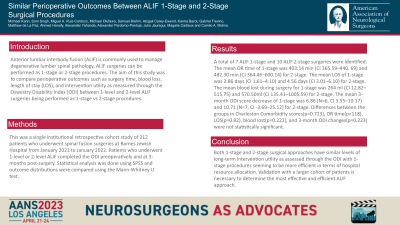Similar Perioperative Outcomes Between ALIF 1-Stage and 2-Stage Surgical Procedures
Similar Perioperative Outcomes Between ALIF 1-stage and 2-stage Surgical Procedures
Friday, April 21, 2023


Samuel N. Brehm, BSME (he/him/his)
Medical Student
Washington University School of Medicine
Corpus Christi, Texas, United States
ePoster Presenter(s)
Introduction: Anterior lumbar interbody fusion (ALIF) is commonly used to manage degenerative lumber spinal pathology. ALIF surgeries can be performed as 1-stage or 2-stage procedures. The aim of this study was to compare perioperative outcomes such as surgery time, blood loss, length of stay (LOS), and patient reported outcomes measured through the Oswestry Disability Index (ODI) between 1-level and 2-level ALIF surgeries being performed as 1-stage vs 2-stage procedures.
Methods: This was a single institutional retrospective cohort study of 212 patients who underwent spinal fusion surgeries at Barnes Jewish Hospital from January 2021 to January 2022 under computer navigation guidance. Patients who underwent 1-level or 2-level ALIF were included. Statistical analysis were performed using SPSS. Perioperative outcomes and the 3-month change in ODI scores post-surgery. Outcome distributions were compared using the Mann-Whitney U test.
Results: A total of 7 ALIF 1-stage and 10 ALIF 2-stage surgeries were identified. The mean OR time of 1-stage was 403.14 min (CI 365.59–440. 69) and 482.30 min (CI 364.46–600.14) for 2-stage. The mean LOS of 1-stage was 2.86 days (CI 1.61–4.10) and 4.56 days (CI 3.01–6.10) for 2-stage. The mean blood lost during surgery for 1-stage was 264 ml (CI 12.82–515.75) and 570.50ml (CI 135.41–1005.59) for 2-stage. The mean 3-month ODI score decrease of 1-stage was 6.86 (N=6, CI 3.55–10.17) and 10.71 (N=7, CI -3.69–25.12) for 2-stage. Differences between the groups in Charlson Comorbidity Index (p=0.723), OR time (p=0.118), LOS (p=0.82), blood lost (p=0.222), and 3-month ODI changes (p=0.223) were not statistically significant.
Conclusion : Both 1-stage and 2-stage surgical approaches have similar levels of long-term intervention utility as assessed through the ODI with 1-stage procedures seeming to be more efficient in terms of hospital resource allocation. Validation with a larger cohort of patients is necessary to determine the most effective and efficient ALIF approach.
Methods: This was a single institutional retrospective cohort study of 212 patients who underwent spinal fusion surgeries at Barnes Jewish Hospital from January 2021 to January 2022 under computer navigation guidance. Patients who underwent 1-level or 2-level ALIF were included. Statistical analysis were performed using SPSS. Perioperative outcomes and the 3-month change in ODI scores post-surgery. Outcome distributions were compared using the Mann-Whitney U test.
Results: A total of 7 ALIF 1-stage and 10 ALIF 2-stage surgeries were identified. The mean OR time of 1-stage was 403.14 min (CI 365.59–440. 69) and 482.30 min (CI 364.46–600.14) for 2-stage. The mean LOS of 1-stage was 2.86 days (CI 1.61–4.10) and 4.56 days (CI 3.01–6.10) for 2-stage. The mean blood lost during surgery for 1-stage was 264 ml (CI 12.82–515.75) and 570.50ml (CI 135.41–1005.59) for 2-stage. The mean 3-month ODI score decrease of 1-stage was 6.86 (N=6, CI 3.55–10.17) and 10.71 (N=7, CI -3.69–25.12) for 2-stage. Differences between the groups in Charlson Comorbidity Index (p=0.723), OR time (p=0.118), LOS (p=0.82), blood lost (p=0.222), and 3-month ODI changes (p=0.223) were not statistically significant.
Conclusion : Both 1-stage and 2-stage surgical approaches have similar levels of long-term intervention utility as assessed through the ODI with 1-stage procedures seeming to be more efficient in terms of hospital resource allocation. Validation with a larger cohort of patients is necessary to determine the most effective and efficient ALIF approach.
